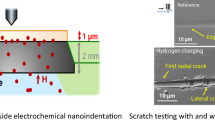Abstract
We applied thermal cycles with a range of −40 to 250 °C to metalized silicon nitride substrates, to both sides of which copper layers had been bonded using the active metal brazing method, and systematically evaluated the effects of the thermal cycles on the roughening of the surface of the metal layer, and on the changes in the structure of the copper layer. The roughening of the metal surface increased with the number of thermal cycles. The period of the long-periodic component of the roughened surface (surface waviness) was 100–300 μm. This value is almost identical to the diameter of the copper grains. The results of electron back-scatter diffraction pattern analysis revealed strain spanning the entire copper crystal, with severe crystal strain appearing near the high-angle grain boundaries in the copper layers subjected to the above thermal cycles, due to repeated cyclic thermal stress arising from a difference in the coefficients of thermal expansion between the metallic and ceramic layers. In a sample subjected to 1000 thermal cycles, the strain within a grain or in the vicinity of a grain boundary becomes more severe as the distance from the ceramic join decreases, while the strain tends to be smaller at the surface of the metal layer. This appears to be due to the copper grains near the surface being subjected to stress, giving rise to out-of-plane displacement, such that the strains tend to be released.






Similar content being viewed by others
References
P. Dietrich, Trends in automotive power semiconductor packaging. Microelectron. Reliab. 53, 1681 (2013)
L. Dupont, Z. Khatir, S. Lefebvre, S. Bontemps, Effects of metallization thickness of ceramic substrates on the reliability of power assemblies under high temperature cycling. Microelectron. Reliab. 46, 1766 (2006)
Y. Nagatomo, T. Kitahara, T. Nagase, Y. Kuromitsu, H. Sosiati, and N. Kuwano, Fracture mechanism of interface between aluminum and aluminum nitride during thermal cycling. J. Jpn. Inst. Met. 72, 433 (2008) (in Japanese)
T.G. Lei, J.N. Calata, K.D.T. Ngo, G.-Q. Lu, Effects of large-temperature cycling range on direct bond aluminum substrate. IEEE Trans. Device Mater. Reliab. 9, 563 (2009)
N. Settus, M. Takahashi, M. Matsushita, and N. Okabe, Mechanical strength properties of Cu/AlN composites subjected to cyclic thermal loadings. J. Soc. Mater. Sci. Jpn. 61, 530 (2012) (in Japanese)
M. Goetz, N. Kuhn, B. Lehmeier, A. Meyer, and U. Boeller, Comparison of silicon nitride DBC and AMB substrates for different applications in power electronics, In: Proceedings of PCIM Europe Conference, 57 (2013)
A. Fukumoto, D. Berry, K.D.T. Ngo, G.-Q. Lu, Effects of extreme temperature swings (−55 °C to 250 °C) on silicon nitride active metal brazing substrates. IEEE Trans. Device Mater. Reliab. 14, 751 (2014)
F. Lang, H. Yamaguchi, H. Nakagawa, and H. Sato, Cyclic thermal stress-induced degradation of Cu metallization on Si3N4 substrate at −40 °C to 300 °C. J. Electron. Mater. 44, 482 (2015)
R. Khazaka, L. Mendizabal, D. Henry, R. Hanna, Survey of high-temperature reliability of power electronics packaging components. IEEE Trans. Power Electron. 30, 2456 (2015)
D. Raabe, M. Sachtleber, H. Weiland, G. Scheele, Z. Zhao, Grain-scale micromechanics of polycrystal surfaces during plastic straining. Acta Mater. 51, 1539 (2003)
Z. Zhao, R. Radovitzky, A. Cuitino, A study of surface roughening in fcc metals using direct numerical simulation. Acta Mater. 52, 5719 (2004)
J. Jiang, T.B. Britton, A.J. Wilkinson, Evolution of intragranular stresses and dislocation densities during cyclic deformation of polycrystalline copper. Acta Mater. 94, 193 (2015)
T. Kajiura, M. Tsukamoto, and A. Yamamoto, Recovery and recrystallization processes in oxygen-free copper after cold-rolling, J. Jpn. Inst. Met. Mater. 78, 126 (2014) (in Japanese)
ISO 17841,Test Method for Thermal Fatigue of Fine Ceramics Substrate, Fine Ceramics (Advanced Ceramics, Advanced Technical Ceramics), International Organization for Standards (2015)
Acknowledgements
This work was supported by Council for Science, Technology and Innovation (CSTI), Cross-ministerial Strategic Innovation Promotion Program (SIP), “Next-generation power electronics/Consistent R&D of next-generation SiC power electronics” (funding agency: NEDO).
Author information
Authors and Affiliations
Corresponding author
Rights and permissions
About this article
Cite this article
Fukuda, S., Shimada, K., Izu, N. et al. Thermal-cycling-induced surface roughening and structural change of a metal layer bonded to silicon nitride by active metal brazing. J Mater Sci: Mater Electron 28, 12168–12175 (2017). https://doi.org/10.1007/s10854-017-7031-2
Received:
Accepted:
Published:
Issue Date:
DOI: https://doi.org/10.1007/s10854-017-7031-2




